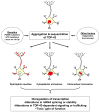TDP-43: a novel neurodegenerative proteinopathy
- PMID: 17936612
- PMCID: PMC2678676
- DOI: 10.1016/j.conb.2007.08.005
TDP-43: a novel neurodegenerative proteinopathy
Abstract
Over the past decade, it has become clear that there is a significant overlap in the clinical spectrum of frontotemporal lobar degeneration and amyotrophic lateral sclerosis (ALS). The identification of TDP-43 as the major disease protein in the pathology of both frontotemporal lobar degeneration with ubiquitin inclusions and ALS provides the first molecular link for these diseases. Pathological TDP-43 is abnormally phosphorylated, ubiquitinated, and cleaved to generate carboxy-terminal fragments in affected brain regions. The normal nuclear expression of TDP-43 is also reduced leading to the hypothesis that sequestration of TDP-43 in pathological inclusions contributes to disease pathogenesis. Thus, TDP-43 is the newest member of the growing list of neurodegenerative proteinopathies, but unique in that it lacks features of brain amyloidosis.
Conflict of interest statement
Figures


References
-
- Forman MS, Trojanowski JQ, Lee VMY. Neurodegenerative diseases: a decade of discoveries paves the way for therapeutic breakthroughs. Nat Med. 2004;10:1055–1063. - PubMed
-
- Xiao S, McLean J, Robertson J. Neuronal intermediate filaments and ALS: a new look at an old question. Biochim Biophys Acta. 2006;1762:1001–1012. - PubMed
-
- Cairns NJ, Bigio EH, Mackenzie IRA, Neumann M, Lee VMY, Hatanpaa KJ, White CL, III, Schneider JA, Grinberg LT, Halliday G, et al. Neuropathologic diagnostic and nosologic criteria for frontotemporal lobar degeneration: consensus of the Consortium for Frontotemporal Lobar Degeneration. Acta Neuropathol. 2007;1145:5–22. - PMC - PubMed
-
Consensus paper on revised criteria for the neuropathological diagnosis of FTLD that incorporates recent advances in molecular genetics, biochemistry, and neuropathology including the identification of TDP-43 as the major disease protein in FTLD-U. The proposed classification scheme includes an algorithm for the neuropathological diagnosis of FTLD and is compared with the previous classification system described in 2001 [16].
-
- Cruts M, Gijselinck I, van der ZJ, Engelborghs S, Wils H, Pirici D, Rademakers R, Vandenberghe R, Dermaut B, Martin JJ, et al. Null mutations in progranulin cause ubiquitin-positive frontotemporal dementia linked to chromosome 17q21. Nature. 2006;442:920–924. - PubMed
-
Identification of PGRN mutations in patients with frontotemporal dementia and parkinsonism linked to chromosome 17 (FTDP-17) and FTLD-U pathology. Interestingly, PGRN is located on chromosome 17q21, 1.7 Mb centromeric of MAPT, in which mutations are associated with FTDP-17 with tau pathology. All of the mutations in PGRN were predicted to cause premature termination of the coding sequence by nonsense mediated decay of mutant mRNAs. In one large Belgian kindred, mutations were identified in the splice donor site of intron 0 causing loss of mutant transcript by nuclear degradation.
Publication types
MeSH terms
Substances
Grants and funding
LinkOut - more resources
Full Text Sources
Other Literature Sources
Medical
Miscellaneous

